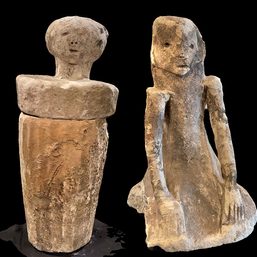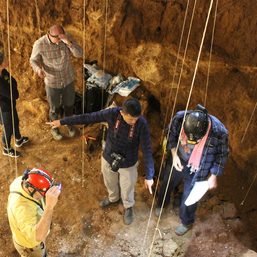SUMMARY
This is AI generated summarization, which may have errors. For context, always refer to the full article.
![[The Slingshot] No, no, no, National Museum! The Boljoon artifacts do not belong to you!](https://www.rappler.com/tachyon/2024/02/tl-boljoon-artifacts-nat-museum-02242024.jpg)
One of the very first things one reads on the website of the National Museum of the Philippines is this requisite line – that it is “A trust of the Government.” That signifies that it is charged with a position of responsibility to the public for whom it must act rightly and fairly; that it is entrusted with care and custody for the interest of the public. Because of that intrinsic nature of its job, it must listen to the people it represents and care for. It does not lord it over them.
A basic question arises: can the Filipino public rely on the National Museum with confidence? Like its destruction of the Relief Map of the Philippines by sculptor Jose Mendoza, a presumed heritage structure because it satisfied the legal criteria of 50 years of age, the National Museum of the Philippines is again treading on dangerous grounds inimical to the public interest it serves.
This time, it has acquired by donation some stolen artifacts. Announcing its exhibition of the artifacts on its Facebook page as “A Gift to the Nation,” it said the objects “trace its provenance from the pulpit of the Patrocinio de Maria Santisima Parish Church in Boljoon, Cebu.”
After it raised outcries that they return the objects to Boljoon, it published a carefully worded clarification that omitted mentioning the provenance of the object. This is where it created more questions than answers. Instead, it made a veiled reference to how the objects came from the Boljoon church in a very indirect way – “our donors procured these specific panels through legitimate means.” Was the previous procurement BEFORE the donors illegitimate? That is what it implies.
When the couple Edwin and Aileen Bautista donated the artifacts (Mr. Bautista is CEO of UnionBank), the first commitment the museum should have made was to return it to its original owner. As a “trust of government,” the first thing it should have done is to right a wrong. Why? Because that is the morally correct thing to do. It is a basic property law universal to all that what was stolen or looted or sold illegally should be returned to its original owner. The NMP failed its first due diligence.
The parameters of repatriation – the return of stolen or looted cultural materials – are easy to understand. As a state museum, we would have expected the NMP to be abreast with current worldwide trends of repatriation. It appears it does not.
The first principle of repatriation can thus be easily answered. Who is the rightful owner of the Boljoon artifacts? The NMP statement already answers that – it is the parish church of Patrocinio de Maria Santisima in Boljoon, Cebu which is part of the Archdiocese of Cebu. The legal personality who presides over that entity at the present time is Archbishop Jose Palma and he has already spoken that they want the objects back. The parish church is a decreed and consecrated Archdiocesan Shrine. There should be no doubt that the Archdiocese of Cebu has the first right of assertion over the return of the objects. The NMP does not enjoy that right. If it does, that is a usurpation of right.
Even if the Bautista couple acquired the objects through legitimate means, it was not so prior to the period it reached their hands. The objects were stolen, period. That is a fact that the people of Boljoon confirm. The NMP’s attitude towards collecting the cultural objects should reflect that. But it does not. A museum is expected to do the full history of any object in its collection accession catalogues. It failed its second due diligence.
The NMP must have, what German museologist Udo Göesswald (president, International Council on Museums [ICOM] Europe) says is an “active questing ethical consciousness to translate their consolidated possessions and bountiful representation into real conversations and proactive relationships with those who have vital interests, through undeniable historical association, with what they hold.”
Instead, the NMP’s second statement seems to suggest that the Boljoon parish church does not have the adequate capability to conserve the objects, and hence that these are safer in the hands of the NMP. But this is self-defeating. In fact, the parish church complex of Boljoon was declared by the NMP as a National Cultural Treasure in 2001. Prior to that, in 1999, the National Historical Institute declared it a National Historical Landmark.
It is thus the duty of the NMP to equip and empower parish or archdiocesan personnel in conservation work. Equipping local personnel will be a sustainable approach because it empowers them to protect their own heritage. The NMP has the training tools for such. Why can’t it do that instead?
The other parameter of repatriation is what is called source community. There is no scintilla of doubt that the source community of the objects is the town of Boljoon. The NMP has a new branch museum in Cebu city. But even if it exhibits it there, that would not be the source community. There is no other source community – it is the town of Boljoon. Cultural preservation is achieved when the objects are returned to Boljoon because the associated activities connected with the objects can only be found there, not within the four walls of any NMP museum.
Experts of museum repatriation know what associated activities mean when objects socialize the community: “their return to the place of origin where the intangible aspects of heritage provide meaning and where the objects themselves may stimulate renewed activities of the intangible aspects of culture.” That intangible heritage can take place only in Boljoon, not in a National Museum gallery or exhibition hall.
Another parameter is cultural context. It is in this respect that the statement of Archbishop Palma falls under. Palma said the objects are considered sacred because they are part of the Church’s missionary work. Moreover, and he expounds it very well, “these panels are considered in the ecclesial rite as tools of evangelization.” If the NMP exhibits them, they would only be mere artworks. Any exhibition in any museum of the NMP cannot achieve the sacral role of the objects. That would be very dishonest on their part.
Let us make it clear: the Bautista couple is not the looter of the artifacts. Their donation is noteworthy. But in donating the objects to the NMP, they were aware that these objects were once stolen from the Church of Patrocinio de Maria Santisima in Boljoon, Cebu. The NMP saying that the objects trace their provenance to Boljoon is an admission that they were once taken surreptitiously from there.
Only the return of the artifacts can put into effect the renewal of the cultural heritage of the people of Boljoon. That is why repatriation is restorative justice. Absent that, Moira Simpson of the University of South Australia warns us: “To ignore, dismiss, or reject requests from indigenous peoples who seek the return of cultural objects that they require to assist in the processes of cultural renewal would suggest that museum professionals are more concerned with preserving artefacts than supporting communities in their efforts to perpetuate the distinct cultures, beliefs, and practices that led to the creation of the artefacts.”
If the NMP insists on keeping the objects as part of its collection, they will act like the colonial looters of yore. That would make them a very bad museum that does not act like the “educational, scientific, and cultural institution” it claims to be. – Rappler.com
Antonio Montalvan II is an anthropologist who has worked as a museum professional curating museums. He was once the head of the National Committee of Museums of the National Commission on Culture and the Arts. He is currently part of a research group of the University of Barcelona aiming to repatriate Filipino objects in museums in Catalunia, Spain back to their source communities in the Philippines.
2 comments
How does this make you feel?
![[Time Trowel] From ancient artifacts to today’s trash: Debunking misconceptions about archaeology](https://www.rappler.com/tachyon/2024/01/archaeology-hny-january-essay.jpg?fit=449%2C449)
![[Time Trowel] From the apes to adobo](https://www.rappler.com/tachyon/2024/01/20240201-TL-evolution.jpg?resize=257%2C257&crop=262px%2C0px%2C720px%2C720px)

![[Time Trowel] From ancient artifacts to today’s trash: Debunking misconceptions about archaeology](https://www.rappler.com/tachyon/2024/01/archaeology-hny-january-essay.jpg?resize=257%2C257&crop=292px%2C0px%2C720px%2C720px)

What was once the property of the Church has now become the property of the State?
I strongly agree with Antonio Montalvan II: “If the NMP insists on keeping the objects as part of its collection, they will act like the colonial looters of yore. That would make them a very bad museum that does not act like the ‘educational, scientific, and cultural institution’ it claims to be.” And perhaps, if I am allowed to add, an evil neocolonial and elitist institution.